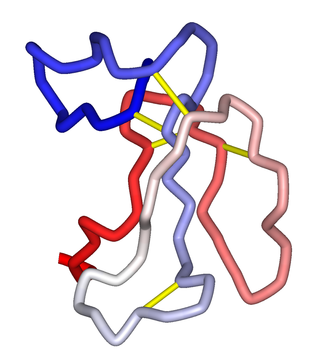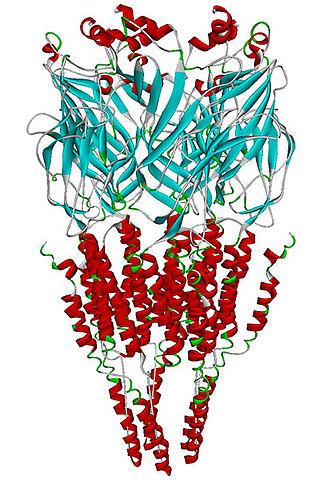Cooperative binding occurs in molecular binding systems containing more than one type, or species, of molecule and in which one of the partners is not mono-valent and can bind more than one molecule of the other species. In general, molecular binding is an interaction between molecules that results in a stable physical association between those molecules.

An acetylcholine receptor is an integral membrane protein that responds to the binding of acetylcholine, a neurotransmitter.

Jacques Lucien Monod was a French biochemist who won the Nobel Prize in Physiology or Medicine in 1965, sharing it with François Jacob and André Lwoff "for their discoveries concerning genetic control of enzyme and virus synthesis".

In biochemistry and pharmacology, receptors are chemical structures, composed of protein, that receive and transduce signals that may be integrated into biological systems. These signals are typically chemical messengers which bind to a receptor and cause some form of cellular/tissue response, e.g. a change in the electrical activity of a cell. There are three main ways the action of the receptor can be classified: relay of signal, amplification, or integration. Relaying sends the signal onward, amplification increases the effect of a single ligand, and integration allows the signal to be incorporated into another biochemical pathway.

Nicotinic acetylcholine receptors, or nAChRs, are receptor polypeptides that respond to the neurotransmitter acetylcholine. Nicotinic receptors also respond to drugs such as the agonist nicotine. They are found in the central and peripheral nervous system, muscle, and many other tissues of many organisms. At the neuromuscular junction they are the primary receptor in muscle for motor nerve-muscle communication that controls muscle contraction. In the peripheral nervous system: (1) they transmit outgoing signals from the presynaptic to the postsynaptic cells within the sympathetic and parasympathetic nervous system, and (2) they are the receptors found on skeletal muscle that receive acetylcholine released to signal for muscular contraction. In the immune system, nAChRs regulate inflammatory processes and signal through distinct intracellular pathways. In insects, the cholinergic system is limited to the central nervous system.

Jean-Pierre Changeux is a French neuroscientist known for his research in several fields of biology, from the structure and function of proteins, to the early development of the nervous system up to cognitive functions. Although being famous in biological sciences for the MWC model, the identification and purification of the nicotinic acetylcholine receptor and the theory of epigenesis by synapse selection are also notable scientific achievements. Changeux is known by the non-scientific public for his ideas regarding the connection between mind and physical brain. As put forth in his book, Conversations on Mind, Matter and Mathematics, Changeux strongly supports the view that the nervous system functions in a projective rather than reactive style and that interaction with the environment, rather than being instructive, results in the selection amongst a diversity of preexisting internal representations.

In biochemistry, the Monod-Wyman-Changeux model describes allosteric transitions of proteins made up of identical subunits. It was proposed by Jean-Pierre Changeux in his PhD thesis, and described by Jacques Monod, Jeffries Wyman, and Jean-Pierre Changeux. It contrasts with the sequential model.

α-Bungarotoxin is one of the bungarotoxins, components of the venom of the elapid Taiwanese banded krait snake. It is a type of α-neurotoxin, a neurotoxic protein that is known to bind competitively and in a relatively irreversible manner to the nicotinic acetylcholine receptor found at the neuromuscular junction, causing paralysis, respiratory failure, and death in the victim. It has also been shown to play an antagonistic role in the binding of the α7 nicotinic acetylcholine receptor in the brain, and as such has numerous applications in neuroscience research.

Desformylflustrabromine (dFBr) is a monomethyltryptamine derivative which was first isolated as a secondary metabolite of the marine bryozoan Flustra foliacea.

The human muscarinic acetylcholine receptor M5, encoded by the CHRM5 gene, is a member of the G protein-coupled receptor superfamily of integral membrane proteins. It is coupled to Gq protein. Binding of the endogenous ligand acetylcholine to the M5 receptor triggers a number of cellular responses such as adenylate cyclase inhibition, phosphoinositide degradation, and potassium channel modulation. Muscarinic receptors mediate many of the effects of acetylcholine in the central and peripheral nervous system. The clinical implications of this receptor have not been fully explored; however, stimulation of this receptor is known to effectively decrease cyclic AMP levels and downregulate the activity of protein kinase A (PKA).

The alpha-7 nicotinic receptor, also known as the α7 receptor, is a type of nicotinic acetylcholine receptor implicated in long-term memory, consisting entirely of α7 subunits. As with other nicotinic acetylcholine receptors, functional α7 receptors are pentameric [i.e., (α7)5 stoichiometry].
In pharmacology and biochemistry, allosteric modulators are a group of substances that bind to a receptor to change that receptor's response to stimulus. Some of them, like benzodiazepines, are drugs. The site that an allosteric modulator binds to is not the same one to which an endogenous agonist of the receptor would bind. Modulators and agonists can both be called receptor ligands.

Coronaridine, also known as 18-carbomethoxyibogamine, is an alkaloid found in Tabernanthe iboga and related species, including Tabernaemontana divaricata for which it was named.
Peter Nigel Tripp Unwin FRS is a British scientist at the MRC Laboratory of Molecular Biology, where he was Head of the Neurobiology Division from 1992 until 2008. He is currently also Emeritus Professor of Cell Biology at the Scripps Research Institute.
Arthur Christopoulos is an Australian Professor of Analytical Pharmacology at Monash University. He is the recipient of numerous national and international awards, including the 2013 John J. Abel Award from the American Society for Pharmacology and Experimental Therapeutics and the Rand Medal from the Australasian Society of Clinical and Experimental Pharmacologists and Toxicologists, the 2014 IUPHAR Analytical Pharmacology Lecturer, a 2015 Doctor of Laws from the National and Kapodistrian University of Athens, Greece, the 2016 recipient of the Gaddum Memorial Award from the British Pharmacological Society and the 2016 GSK Award for Research Excellence. Since 2014, Clarivate Analytics has regularly named him a Highly Cited Researcher in Pharmacology and Toxicology. In 2021, Arthur was named a Highly Cited Researcher in both Pharmacology and Toxicology and Biology and Biochemistry categories. In 2017 he was elected a Fellow of the Australian Academy of Health and Medical Sciences and in 2018 he was elected as a Councillor of the International Union of Basic and Clinical Pharmacology and a Fellow of the British Pharmacological Society. In 2019 he was appointed Dean of Monash University's Faculty of Pharmacy and Pharmaceutical Sciences and in 2021 was appointed as the inaugural Director of Monash University's Neuromedicines Discovery Centre. He was elected a Fellow of the Australian Academy of Science in 2021.
Nicolas Le Novère is a British and French biologist. His research focuses on modeling signaling pathways and developing tools to share mathematical models.

Maxime Simon Schwartz, born in June 1940 in Blois (Loir-et-Cher), is a French molecular biologist who has been a research director at the CNRS, a professor at the Pasteur Institute and Director General of the Pasteur Institute. He is a correspondant of the French Academy of sciences.

Marina Rachel Picciotto is an American neuroscientist known for her work on the role of nicotine in addiction, memory, and reward behaviors. She is the Charles B. G. Murphy Professor of Psychiatry and professor in the Child Study Center and the Departments of Neuroscience and of Pharmacology at the Yale University School of Medicine. Since 2015, she has been editor-in-chief of the Journal of Neuroscience.
Stephen F. Heinemann (1939–2014) was a professor of neuroscience at the Salk Institute. He was an early researcher in the field of molecular neuroscience, contributing to the current knowledge of how nerves communicate with each other, and the role of neurotransmitters. Stephen Heinemann died August 6, 2014, of kidney failure.

The MRC Weatherall Institute of Molecular Medicine at the University of Oxford is a research institute located at the John Radcliffe Hospital in Oxford. Founded in 1989 by Sir David Weatherall, the institute focuses on furthering our understanding of clinical medicine at a molecular level. It was one of the first institutes of its kind in the world to be dedicated to research in this area.














